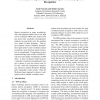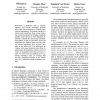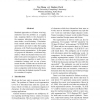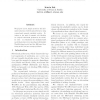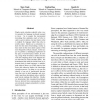ACL
2007
14 years 1 months ago
2007
Speech recognition in many morphologically rich languages suffers from a very high out-of-vocabulary (OOV) ratio. Earlier work has shown that vocabulary decomposition methods can ...
ACL
2008
14 years 1 months ago
2008
Documents in languages such as Chinese, Japanese and Korean sometimes annotate terms with their translations in English inside a pair of parentheses. We present a method to extrac...
ACL
2008
14 years 1 months ago
2008
Question answering research has only recently started to spread from short factoid questions to more complex ones. One significant challenge is the evaluation: manual evaluation i...
ACL
2008
14 years 1 months ago
2008
This paper proposes a method to correct English verb form errors made by non-native speakers. A basic approach is template matching on parse trees. The proposed method improves on...
ACL
2007
14 years 1 months ago
2007
Standard approaches to Chinese word segmentation treat the problem as a tagging task, assigning labels to the characters in the sequence indicating whether the character marks a w...
ACL
2008
14 years 1 months ago
2008
We propose a language model based on a precise, linguistically motivated grammar (a hand-crafted Head-driven Phrase Structure Grammar) and a statistical model estimating the proba...
ACL
2007
14 years 1 months ago
2007
We propose a new, simple model for the automatic induction of selectional preferences, using corpus-based semantic similarity metrics. Focusing on the task of semantic role labeli...
ACL
2008
14 years 1 months ago
2008
People rarely articulate explicitly what a native speaker of a language is already assumed to know. So to acquire the stereotypical knowledge that underpins much of what is said i...
ACL
2007
14 years 1 months ago
2007
Data sparseness is one of the factors that degrade statistical machine translation (SMT). Existing work has shown that using morphosyntactic information is an effective solution t...
